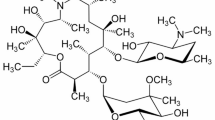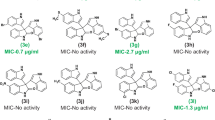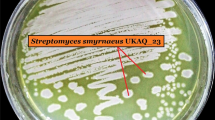Abstract
Anthracimycin is a recently discovered novel marine-derived compound with activity against Bacillus anthracis. We tested anthracimycin against an expanded panel of Staphylococcus aureus strains in vitro and in vivo. All strains of S. aureus tested, including methicillin-susceptible, methicillin-resistant (MRSA) and vancomycin-resistant strains of S. aureus, were susceptible to anthracimycin at MIC values of ⩽0.25 mg l−1. Although its postantibiotic effects were minimal, anthracimycin exhibited potent and rapid bactericidal activity, with a >4-log kill of USA300 MRSA within 3 h at five times its MIC. At concentrations significantly below the MIC, anthracimycin slowed MRSA growth and potentiated the bactericidal activity of the human cathelicidin, LL-37. The bactericidal activity of anthracimycin was somewhat mitigated in the presence of 20% human serum, and the compound was minimally toxic to human cells, with an IC50 (inhibitory concentration 50)=70 mg l−1 against human carcinoma cells. At concentrations near the MIC, anthracimycin inhibited S. aureus nucleic acid synthesis as determined by optimized macromolecular synthesis methodology, with inhibition of DNA and RNA synthesis occurring in the absence of DNA intercalation. Anthracimycin at a single dose of 1 or 10 mg kg−1 was able to protect mice from MRSA-induced mortality in a murine peritonitis model of infection. Anthracimycin provides an interesting new scaffold for future development of a novel MRSA antibiotic.
Similar content being viewed by others
Log in or create a free account to read this content
Gain free access to this article, as well as selected content from this journal and more on nature.com
or
References
David, M. Z., Medvedev, S., Hohmann, S. F., Ewigman, B. & Daum, R. S. Increasing burden of methicillin-resistant Staphylococcus aureus hospitalizations at US academic medical centers, 2003–2008. Infect. Control. Hosp. Epidemiol. 33, 782–789 (2012).
Klein, E. Y., Sun, L., Smith, D. L. & Laxminarayan, R. The changing epidemiology of methicillin-resistant Staphylococcus aureus in the United States: a national observational study. Am. J. Epidemiol. 177, 666–674 (2013).
Uhlemann, A. C., Otto, M., Lowy, F. D. & Deleo, F. R. Evolution of community- and healthcare-associated methicillin-resistant Staphylococcus aureus. Infect. Genet. Evol. 21, 563–574 (2013).
Oh, D. C., Kauffman, C. A., Jensen, P. R. & Fenical, W. Induced production of emericellamides A and B from the marine-derived fungus Emericella sp. in competing co-culture. J. Nat. Prod. 70, 515–520 (2007).
Hughes, C. C., Prieto-Davo, A., Jensen, P. R. & Fenical, W. The marinopyrroles, antibiotics of an unprecedented structure class from a marine Streptomyces sp. Org. Lett. 10, 629–631 (2008).
Asolkar, R. N., Kirkland, T. N., Jensen, P. R. & Fenical, W. Arenimycin, an antibiotic effective against rifampin- and methicillin-resistant Staphylococcus aureus from the marine actinomycete Salinispora arenicola. J. Antibiot. 63, 37–39 (2010).
Sun, P. et al. Fijimycins A–C, three antibacterial etamycin-class depsipeptides from a marine-derived Streptomyces sp. Bioorg. Med. Chem. 19, 6557–6562 (2011).
Sakoulas, G. et al. Novel bacterial metabolite merochlorin A demonstrates in vitro activity against multi-drug resistant methicillin-resistant Staphylococcus aureus. PLoS One 7, e29439 (2012).
Jang, K. H. et al. Anthracimycin, a potent anthrax antibiotic from a marine-derived actinomycete. Angew. Chem. Int. Ed. Engl. 52, 7822–7824 (2013).
Haste, N. M. et al. Pharmacological properties of the marine natural product marinopyrrole A against methicillin-resistant Staphylococcus aureus. Antimicrob. Agents Chemother. 55, 3305–3312 (2011).
Cunningham, M. L., Kwan, B. P., Nelson, K. J., Bensen, D. C. & Shaw, K. J. Distinguishing on-target versus off-target activity in early antibacterial drug discovery using a macromolecular synthesis assay. J. Biomol. Screen. 18, 1018–1026 (2013).
Sakoulas, G. et al. Ampicillin enhances daptomycin- and cationic host defense peptide-mediated killing of ampicillin- and vancomycin-resistant Enterococcus faecium. Antimicrob. Agents Chemother. 56, 838–844 (2012).
Acknowledgements
This work was supported by the National Institutes of Health (NIH) Training Program in Marine Biotechnology (T32 GM067550), a Ruth L Kirschstein National Research Service Award (NRSA) from National Institutes of Health Grants (5 F31 GM090658-02) and by National Institutes of Health Grant GM084350 to WF and VN. Part of this work was funded by the Transformational Medical Technologies program contract HDTRA1-10-C-004 from the Department of Defense Chemical and Biological Defense program through the Defense Threat Reduction Agency. We gratefully acknowledge the in vivo technical expertise of Joshua Olson.
Author information
Authors and Affiliations
Corresponding author
Rights and permissions
About this article
Cite this article
Hensler, M., Jang, K., Thienphrapa, W. et al. Anthracimycin activity against contemporary methicillin-resistant Staphylococcus aureus. J Antibiot 67, 549–553 (2014). https://doi.org/10.1038/ja.2014.36
Received:
Revised:
Accepted:
Published:
Issue date:
DOI: https://doi.org/10.1038/ja.2014.36
Keywords
This article is cited by
-
Repellency and insecticidal activity of seven Mugwort (Artemisia argyi) essential oils against the malaria vector Anopheles sinensis
Scientific Reports (2022)
-
2-Epi-anthracimycin, a new cytotoxic agent from the marine-derived actinomycete Streptomyces sp. OPMA00631
The Journal of Antibiotics (2020)
-
Special issue dedicated to William Fenical: a pioneer in marine/marine-derived microbial chemistry
The Journal of Antibiotics (2020)
-
Production of macrolide antibiotics from a cytotoxic soil Streptomyces sp. strain ZDB
World Journal of Microbiology and Biotechnology (2017)
-
Alternative pre-approved and novel therapies for the treatment of anthrax
BMC Infectious Diseases (2016)



